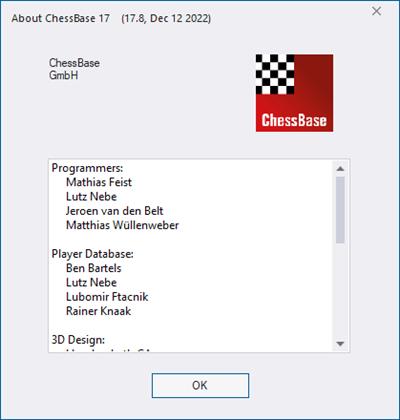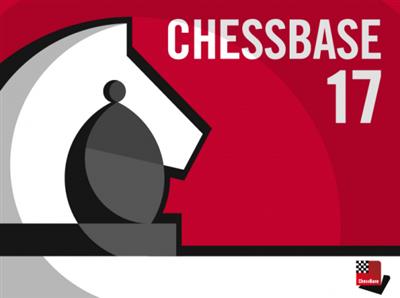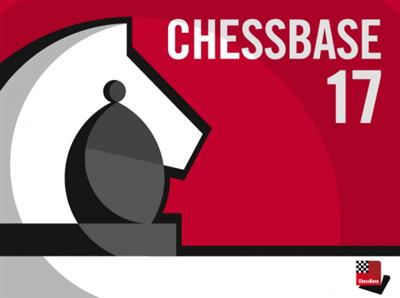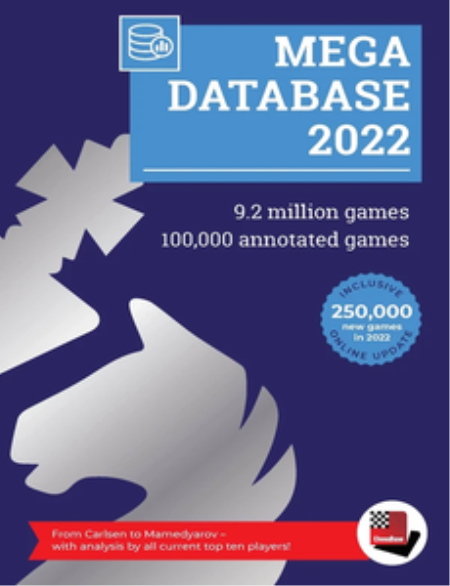
ChessBase 17.8 Multilingual
Posted on 17 Dec 11:36 | by mitsumi | 27 views

Languages: Multilingual | File Size: 290 MB
ChessBase is a personal, stand-alone chess database that has become the standard throughout the world. Everyone uses ChessBase, from the World Champion to the amateur next door. It is the program of choice for anyone who loves the game and wants to know more about it. Start your personal success story with ChessBase and enjoy the game even more.
What you can do with ChessBase
- Retrieve games according to openings, players and tournaments
- Generate tournament cross tables and full graphic statistics of players or openings
- "Similarity search" shows all games with similar pawn structures, sacrifice patterns, endgame positions, etc.
- "Let's check": access the world's largest database of in-depth analysis (more than 200 million positions)
- "Instant Analysis": Any unannotated game is analysed almost without delay immediately on loading (optional)
- "Assisted Analysis": as you enter a game, whenever you click on a piece an evaluation is produced for all its possible target squares
- "Tactical Analysis" will annotate game, inserting commentary, variations and diagrams, before strong moves or errors, into a game or an entire database. It will also point out combinations, played in the game or missed, tries, attacks, initiative, and of course the latest in openings theory
- Cloud analysis: you can analyse positions simultaneously with several engines from on different computers running in parallel
- "Deep analysis": generates an analysis tree that changes dynamically, as with time weaker variations are dropped
- Automatic analysis jobs for correspondence games
- "Replay Training": Playing through a game with the notation hidden and automatic training questions with tips for each individual move. Extended reference search for openings shows increase/decrease in popularity and typical recurring endgames
- Merge games on the fly into an opening tree
- Generate a dossier containing all available information on a specific player from the database
- Generate a comprehensive openings report with main and critical lines, plans and most important games
- Single click publication of games on the Internet
- Improved search mask with tactical motifs and examples for manoeuvres and material distribution
- Completely new search booster for patterns and plans
- Print games in superb quality with diagrams and multiple columns
- Crisp new 3D boards thanks to raytracing technology
The most important innovations
ChessBase 17 focusses at things that, in our view, are the foremost of the program's areas of application. First of all, a lot of work has gone into functions that one only notices subconsciously, but which improve the user experience: the new ultra-high-resolution 2D board; the really crisp display of notation and lists through support of Direct 2D which runs on all recent Windows versions; and popular in more recent times: the "Dark Mode".
Technical improvements
Then there are many technical improvements that generally improve the program, such as: a new faster data format, with fewer files and no search booster - which overcomes limitations of the CBH format; and a fine-tuning of the database paths that solves conflicts with the Documents directory and OneDrive, so you can smoothly manage your databases outside the standard Windows directories.
Interactive search mask and much more
The smart inputting of positions is of direct chess significance. You place a few pieces onto the board, and immediately see in which games of the reference database this position fragment occurs. By clicking on a game, you can save yourself the rest of the inputting. The new search mask is also more interactive: if you enter a search criterion, the number of games in the database for which it matches is immediately displayed. This way, you know what yield to expect before you click on "OK".
The new engine window
A lot has also been done in an area that is crucial for daily chess work: the engine window. Most ChessBase users probably spend 90% of their time with interactive analysis of positions. The output of engines has altered little in the last 30 years: variations, evaluations, dry as dust, done. In ChessBase 17, this has been fundamentally re-evaluated. The visual evaluation of pieces and measurement of complexity - you know from Fritz 18. The display of non-trivial threats or temptations is fancy, but also already familiar. The same goes for the training option to suppress the entire engine output, and only receive subtle tips as a stimulus to your own thinking. This is primarily intended for when watching live games.
Analysis in natural language
However, the interpretation of an engine variation in natural language is groundbreakingly new. It is often a challenge for many players to imagine what is actually happening based on just an engine variation. You see the best move, the rating, and that's it. ChessBase 17 describes in words what the variation entails.
For example: In a super-sharp position, a complex variation has the strange rating "0.00". ChessBase 17 would then add "perpetual check" or "repetition of the position" and the situation would become clear. Material changes are vividly described: "White wins the queen for rook and knight"; "Black loses two pawns"; and even "The position is simplified into an endgame R+B vs R+N". There are also exciting statements like: "White gains a dangerous passed pawn on e6"; or "White sacrifices a bishop"; "Black has an attack"; "White gets the majority on the kingside"; "Both kings are insecure"; and "Manoeuvre Nd2-f1-e3-d5" etc.
Such assertions clarify the motives behind a position. If you want to understand even more of what the program means by these hints, simply move the mouse over the move indicated and the position appears on the main board. Clicking on a move copies the variation up to that move into the notation, which then simplifies the commentary.
It does make a difference whether a position contains sharply forced variations, or several moves of almost equal value. Today's engines do not provide this information. ChessBase 17 therefore diverts a small part of the hardware resources towards a clone of the main engine, and calls this the "Buddy engine" - this only slightly impacts the computing power of the main engine. Buddy now goes over the variations, and analyses the position after each move. The variations are saved so that you can easily view them by moving your mouse cursor over on the move. Importantly, forced moves are annotated with coloured rectangles. The exclamation mark used in commenting on games for 170 years, doesn't do justice to Buddy's search results; therefore, we now only use it for sacrifices
The colour of the rectangles indicates the evaluation. The shape shows from which depth the forcing is recognised in the calculation. Trivial tactics have vertically divided rectangles. Medium forcing divides the rectangle into two triangles from top left to bottom right. Deep forcing divides diagonally from right to left. If the upper (or left) part is green, the move wins. If the lower part is yellow, for example, the position remains roughly in the draw range after the worse alternative move. If it is red, the alternative move loses. This system may seem complex at first glance, but it has the advantage that a lot of information is signaled in one space-saving symbol. The exclamation mark has had its day. In any case, one thing is clear: the more colourful, the more forcing!
For years, we have recommended analysing with two engine variations, so that at least one forced main move can be recognised immediately. However, this costs a lot of additional computing time. ChessBase 17 marks the beginning of a renaissance of single-variation analysis. At the same time, the calculation goes much deeper. Buddy shows whether the first move is forced, and also provides the second variation.
New in ChessBase 17
- New data format: fewer files, more functions, more comfort, more speed.
- Engine analysis renovated: Variants are automatically verbally annotated, forced continuations are recognized, "buddy heuristics" for greater search depth!
- Pearl search: Find spectacular games instantly! Beautiful games are marked in the database list.
- Optimised program interface: high-resolution 2D board, faster graphics.
- New clearer search mask: material & positional searches simplified, immediate feedback on expected results.
- Intelligent position input: when setting up pieces, you are shown the games where those positions occur.
- Dozens of detail improvements for improved usability, e.g. automatic loading of the last edited game.
- Control via One-Drive: all database paths can be set in the options dialogue.
- Newly structured game notation: with intelligent folding and symbols.
- Modern integrated browser for all database texts.
- More insight: Visualisation of attack correlations (optional).
- Dark Mode: darkened program interface.
Release Notes
- Release notes were unavailable when this listing was updated.
System Requirements
- Minimum: Desktop PC or Notebook, 4 Threads, 8 GB RAM, Windows 8.1 64bit, DirectX 10 graphics card with 1 GB RAM
- Recommended: PC Intel Core i7 or AMD Ryzen Processor with 8 Threads, 16 GB RAM, Windows 10/11 64bit, DirectX 11 graphics card (or compatible) with 1 GB RAM or more
Interface languages: English, Čeština, Deutsch, Français, Español, Italiano, Nederlands, Polski.

Homepage:
https://shop.chessbase.comDownload link
rapidgator.net:
uploadgig.com:
[/b]:
[b]1dl.net:
Related News
System Comment
Information
 Users of Visitor are not allowed to comment this publication.
Users of Visitor are not allowed to comment this publication.
Facebook Comment
Member Area
Top News



